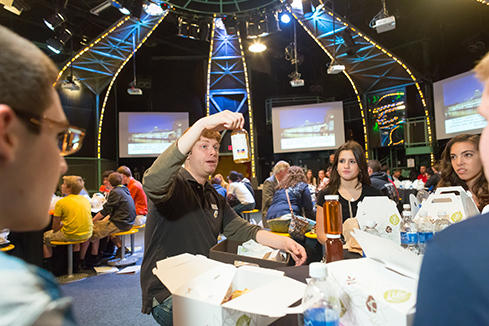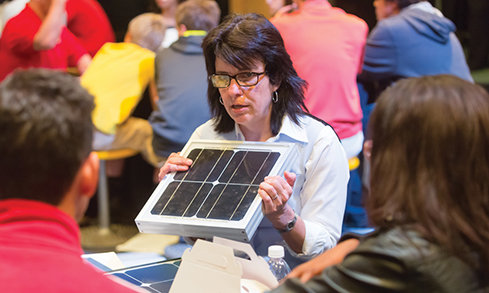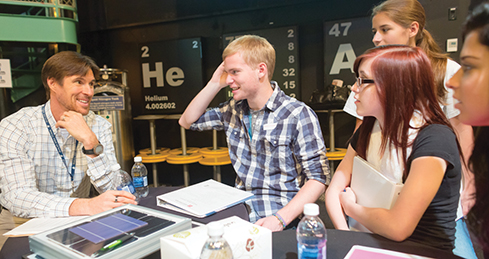 |
||||||||
"My kids are most interested in what's going on in the world today, and what opportunities are out there for them once they leave high school" - Steve Guydo, McKeesport Engineering Teacher |
What's your energy IQ?
Carnegie Museums gives the next generation of big thinkers plenty to think about at every flip of a switch. Six months ago, 15-year-old Rori Cain would leave every light on inside her Penn Hills home. Today, flipping the off switch is a mindful act for the teen, but not for the reason you—or any cost-conscious parent—might think. “It’s crazy how much water is used to generate electricity!” exclaims Cain, a 10th-grader at Shadyside Academy, with a combined sense of awe and alarm. “I shut the lights off not just to conserve energy, but to conserve water.” It’s a simple but powerful take-home message honed during a semester-long program at Carnegie Museum of Natural History. Dubbed Energy-NET and funded by the National Science Foundation, it gave Cain and 16 other area teenagers an up-close look at some of the region’s chief energy sources, including NRG Energy’s coal-fired power plant in Springdale which, as the group learned, uses a whopping 35 to 40 million gallons of water—much of it from the Allegheny River—each day. Now in its second year, the program pairs museum educators with University of Pittsburgh geoscientists, undergraduate environmental science majors, and learning researchers to empower area high schoolers like Cain to think critically about energy and the environment. The museum then challenges the students to communicate what they’ve learned to visitors through energy-themed exhibits that they help create. It’s an ambitious undertaking, not only because energy is a complex subject, but because the program’s numerous field trips, hands-on workshops, and hang-out sessions with scientists require significant after-school—and an occasional Saturday—time commitment from busy teens. For Cain, a curious, science-minded student who gushes over the coolness of chemistry, the program was a natural draw. Others, such as 14-year-old Tonesha Proctor of the Hill District, were a tougher sell. By no means a science buff, Proctor gave Energy-NET a try after being recruited by the museum at her community library, and she’s officially been won over.
“People hear science and maybe they think it’s boring,” she says. “But they don’t know how much fun we’re having.” So much so that Proctor ended up bringing three friends into the fold, including Michelle Sheppard, a fellow sophomore at Pittsburgh Public’s magnet program, University Prep, who’s since discovered she’s a budding naturalist. “The kids are forming what this program is,” says Mary Ann Steiner, director of research on learning at the Museum of Natural History who oversees this and other teen programs along with Angela Scardina, the museum’s youth programs manager who helps develop and implement all stages of Energy-NET, from student recruitment to curriculum. “We’re providing a framework, but we’re not delivering it to them—we’re doing it with them.” That’s a strategy shared by Carnegie Science Center, a regional leader in STEM (science, technology, engineering, and math) educational programming. In October, as part of its Chevron Center for STEM Education and Career Development, the Science Center piloted a day-long Student Energy Summit for 130 area high school students. The students’ task: Explore six different energy technologies through hands-on activities—the renewable resources of wind, solar, and hydropower, and the non-renewable resources of coal, natural gas, and nuclear energy—then make judgments about in what proportions they could best meet the region’s energy needs. Students participating in both programs quickly learn that southwestern Pennsylvania is a significant player in the global energy economy—with more than 1,000 companies in the energy sector that boast 41,000 jobs and a $19 billion economic impact. “Our students need to be prepared both as the future workforce and as informed citizens of the 21st century,” says Linda Ortenzo, the Science Center’s director of STEM programs. “Our unique role is to connect teachers, students, and industry professionals in meaningful ways to help drive that process.” Real-world scienceThe Science Center starts touting its energyrelated lessons—about fossil fuels, conservation, and climate change—to kids as young as age 6. Mike Hennessy, the educator-turnedmad scientist who pulls out all the stops to get grade-schoolers turned on to science, is also the guy tapped to work his special brand of magic on the group of mostly high school juniors and seniors at the Student Energy Summit, made possible by Robert M. Thompson, Jr. and Family and Chevron. After explaining that fossil fuels—coal, oil, and natural gas—come from things that were once alive, Hennessy asks the students seated inside the Science Center’s sprawling Bayer Science Stage to repeat after him: “time, heat, and pressure…time, heat, and pressure.” Those are the three forces, he notes, responsible for converting ancient ocean-dwelling algae, mud, and sediment into Marcellus Shale, a long stretch of sedimentary rock found beneath large parts of the country’s eastern states, including Pennsylvania. Its claim to fame: the Marcellus Shale contains largely untapped natural gas reserves. "Don't be afraid to dream big. Failure is your best teacher."
- Jay Whitacre, a material scientist and owner of Aquion EnergyBut in order to capture the gas inside the shale, Hennessy explains, energy companies had to find a way to break apart, or fracture, the ancient rock. First, they send electrical charges down through the earth from the surface, and this electricity opens tiny nooks and crannies in the rock. To demonstrate this process, he asks for three volunteers who “aren’t afraid of getting shocked.” At Hennessy’s prompting, three young men touch pinkies— representing shale rocks packed tightly together —and, when he gives them a quick jolt of electricity using an electrostatic generator, their pinkies break apart, hypothetically releasing natural gas. It’s then, Hennessy explains, that hydraulic fracturing, or “fracking,” occurs— which calls for drilling down through the earth as much as 10,000 feet, then turning at a 90- degree angle and drilling horizontally several thousand more feet, and then pumping millions of gallons of water, sand, and chemical additives into the shale. T he sand holds the fractures open so that the maximum amount of gas can be extracted. It’s just this kind of interactive demonstration that drew Steve Guydo, an engineering teacher from McKeesport, and his class to the summit. “My kids are most interested in what’s going on in the world today, and what opportunities are out there for them once they leave high school,” he says. Cue guest speaker Jay Whitacre, a material scientist and associate professor at Carnegie Mellon University, who shared with the students a staggering statistic: that all the batteries on Earth can store only 10 minutes of the world’s electricity needs. So he developed a cutting-edge, renewable-energy solution: an Aqueous Hybrid Ion battery system used to store solar and wind power. His company, Pittsburgh-based Aquion Energy, operates the only factory in the world currently manufacturing this kind of portable technology. Whitacre tells the audience of budding scientists, “Don’t be afraid to dream big. Failure is your best teacher.” Useful advice for the group’s immediate challenge: to help the city of Pittsburgh achieve its Climate Action Plan goal of a 20 percent reduction in its greenhouse gas emissions— 6.79 million tons of carbon dioxide— by the year 2023. “How do we do this?” Hennessy asks. “Consider habitat conservation—using fossil fuels, but using them more efficiently; looking at nuclear power; and expanding our mix of renewals. This is where you guys come in.” In teams of about 20, teens from a diverse mix of schools, including Canon McMillan, Carmichaels, North Hills, and Woodland Hills, break off into workshops designed to help them explore their respective energy, a process that’s expected to extend back into their home classrooms. Speed dating for science loversOver a sandwich and chocolate chip cookies inside the Science Center’s Works Theater, a wide range of energy-industry professionals —a petroleum geologist, an aerospace engineer, even a price forecaster—talk turkey with the Energy Summit students about their personal experiences in the energy industry. Rotating from table to table every five minutes or so—imagine a kind of professional speed dating meets working lunch— the experts offer snapshots of what they do for a living, what path they took to get there, and an occasional word or two of advice.
“I studied rocks in school, but there are lots of other opportunities in the field: safety professionals, engineers of all kinds, land guys,” explains Ian Lucas, a senior production geologist for Shell, to a table of engineering students from McKeesport. He shows them a small chunk of Marcellus Shale. “I map the rocks in the subsurface and tell them where to drill and how far. I can be proven how wrong or how right my science is by drilling.” Karen Foltz, founder of Vox Energy Solutions, a solar and wind technology company, came armed with solar panels and the answer to a common question: yes, solar panels do in fact work in cloudy western Pennsylvania. (They use radiation from the sun, rather than sunshine, to make electricity.) She notes that for an investment of about $18,000 after state and federal rebates, an average home can be fitted with a solar system that will last 30 years. “It will take you seven years to pay it off, then you get 23 years of free electricity.” The downside? Aesthetics and high up-front costs. On LCD screens around the room, fast facts set the tone: the starting salary for an energy engineer is $60,000; women in STEM careers make 33 percent more than women in non-STEM careers. “My best advice?” says Sheryl Taylor, a civil engineer and project manager for Chevron, to Elon Ford, an 11th-grade gifted student from Woodland Hills. “Pick what you love.” Alec Casperson, an enterprising junior from McKeesport studying software engineering, decided to seize the moment and ask AC Dasko, an electrical engineer and manager of consolidated hydros at First Energy, to be a mentor for his school’s robotics team—an idea Dasko seemed to welcome. “We could use his electrical guidance and he seems like a nice guy, so why not ask?” says Casperson. “How’s that for networking?” Sharing what you knowBack at the Museum of Natural History, the Energy-NET team spent the summer exploring the connection between water and energy, with a focus on Pittsburgh’s three rivers. Their guides included Pitt geology fellow Marion Divers and four Pitt undergraduate environmental science majors who served as mentors to the students. It was at the coal-fired power plant in July that Rori Cain, Tonesha Proctor, and Michelle Sheppard—joined by 14 of their peers—learned that much of the region’s electricity is generated the same way: a fossil fuel, in this case coal, is burned in order to turn water into steam, which then turns a turbine and runs magnets through an electrical coil to produce electricity. It’s a lesson that not only brought textbook reading to life—it got the students hooked on exploring what they dubbed the “secret life of water.” Over three months, in a hands-on workshop led by Divers, the students replicated a watershed with a tarp and a kiddie pool. Then, with field notebooks at the ready, they visited the nearby Panther Hollow watershed; the Pittsburgh Water and Sewer Authority, where they traced water from the Allegheny River to their sink faucets and toilet bowls; and the Allegheny County Sanitary Authority, where they discovered how the region’s wastewater— including raw sewage, industrial chemicals, and runoff—is treated and then discharged into the Ohio River. The group also took a spin on Riverquest, the floating river learning center; took water samples at the acid mine drainage pools at Powdermill Nature Reserve; and even experienced the power of water firsthand during a white water rafting trip at Ohiopyle State Park. All the while, the teens interacted with scientists and other industry professionals, both at the museum and on field trips, to get a real-world glimpse of science at work. “They’re talking to people not only about what they do, but how they got there, and we hope it’s sending a clear message that there are lots of rich job opportunities in the geosciences,” says Emily Elliott, assistant professor of geology and planetary science at Pitt and one of the architects of Energy-NET. “Employment projections are pretty astounding—like a 30 percent growth rate—and you don’t need a PhD to get a well-paying job.” The students’ final lessons didn’t come from the scientific community: They came from a writer’s lab in Garfield, called Literary Arts Boom, and learning researchers from Pitt who coached the group on creative writing and thinking about the visitor in exhibit design. Finally, the Energy-NET students were charged with sharing their newfound knowledge on the museum floor in an engaging and, of course, cost-effective exhibit fit for audiences of all ages. The final fruit of their labor? An exhibit dubbed The Water-Energy Nexus: Watt About It? that clues museum visitors into, among other things, the fact that power generation accounts for nearly 40 percent of the water usage in the United States. An interactive component points out that coal, natural gas, and nuclear power plants use the most, while renewable energy like wind and solar use the least. “I don’t know that any one kid could explain each and every component of the exhibit, but they absolutely can communicate about the parts they worked on, and that’s a good start, ” says Rachel Smith, a Pitt senior who spent 160 hours with the students to fulfill an internship in environmental science. “I know this program has been a huge benefit to me,” she adds. “You think you understand something, but when you’re forced to synthesize it and explain it to a group of kids, you have to take it to the next level of understanding.” It’s a fact not lost on the teens. So how’s it feel to develop an exhibit at the museum you love? “I guess a little crazy,” says Proctor. It doesn’t hurt that the experience looks good on a college application. For Rori Cain, the thrill is all about seeing science come alive. “I love chemistry,” she gushes. “Now, to see how it’s used in real life and what it means for the earth—the possibilities seem endless.”
|
|||||||
A Playful, Soulful Spectacle · Energy in Human Form · For the Love of Bugs · Directors' Note · NewsWorthy · Face Time: Donald Warhola · Artistic License: Girl Power · Field Trip: Pop goes China · About Town: Art for All · The Big Picture
 |
Copyright © 2017 CARNEGIE Magazine. All rights reserved. |




